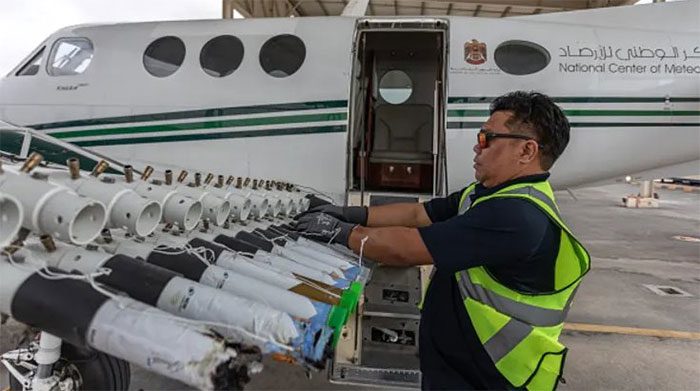Facing a future of severe water scarcity, the United Arab Emirates (UAE) has launched a project to increase regional rainfall.
Rising global temperatures are putting pressure on the Middle East, a region that is extremely vulnerable to the impacts of climate change.
These countries are currently grappling with a significant issue: How to tackle water scarcity?

UAE conducts cloud seeding annually to enhance rainfall. (Illustrative image).
The United Arab Emirates (UAE) receives an average annual rainfall of less than 200 mm, starkly contrasting with London’s average of 1,051 mm and Singapore’s 3,012 mm.
In the UAE, temperatures can soar to 50 degrees Celsius in the summer, and 80% of the country’s landscape is covered by desert terrain. Extreme heat can exacerbate water scarcity and limit agricultural productivity.
The United Nations predicts that by 2025, 1.8 billion people worldwide will face absolute water scarcity. The Middle East is one of the most water-stressed regions, with approximately 83% of the population at high risk of experiencing severe water shortages.
In response to these core challenges, Gulf countries have initiated a project to address this issue.
Cloud Seeding Project
In the 1990s, the UAE introduced a method to enhance rainfall known as cloud seeding. This process involves increasing the amount of precipitation generated from clouds in the sky to improve water scarcity in arid regions.
In the early 2000s, UAE Vice President Sheikh Mansour Bin Zayed Al Nahyan allocated up to $20 million (approximately 494 billion VND) for cloud seeding research. The UAE collaborated with the National Center for Atmospheric Research in Colorado and NASA to implement this program.
The government established a task force called the National Center of Meteorology (NCM) in Abu Dhabi, which conducts over 1,000 hours of cloud seeding each year to enhance rainfall.
The NCM has a radar network and more than 60 weather stations to manage cloud seeding operations and closely monitor atmospheric conditions.

This technology is based on scientific principles. (Image: Getty Images).
How Cloud Seeding Works
Weather forecasters at the center can observe rainfall in clouds and identify which clouds are suitable for additional water seeding, aiming to increase rainfall rates.
Once the right cloud is identified, they guide pilots to fly specialized aircraft equipped with artificial seeding devices on their wings. These devices contain hygroscopic salts that can absorb moisture from the air and create water droplets. When ignited, hygroscopic flares produce fine salt particles that can absorb water vapor and develop into raindrops. When the cloud becomes too heavy, precipitation occurs.
During a visit to the NCM, Director-General Abdulla Al Mandous stated that this technology is based on scientific principles. He also noted that the program in Abu Dhabi does not use silver iodide, a material criticized for its potential harm to the environment and human health.
The NCM stated that they do not use any harmful chemicals in their operations. “Our specialized aircraft only use natural salts and do not employ hazardous chemicals.”
Director Al Mandous mentioned that the center has begun producing its own cloud seeding material known as nano material, a type of fine salt coated with titanium oxide, which is more effective than what they are currently using. He indicated that it would be three times more efficient than hygroscopic flares. This material is currently being tested in various regions in the UAE and the USA.



















































